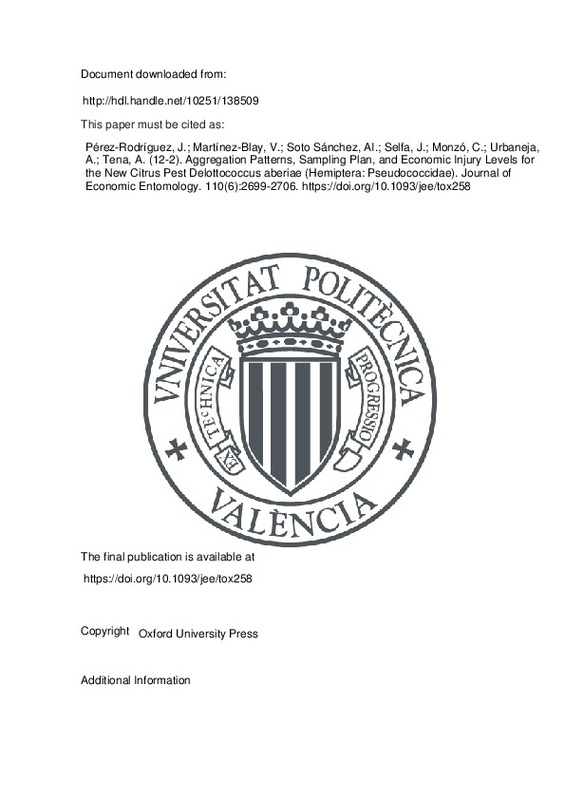Allsopp, P. G. (1991). Binomial sequential sampling of adult Saccharicoccus sacchari on sugarcane. Entomologia Experimentalis et Applicata, 60(3), 213-218. doi:10.1111/j.1570-7458.1991.tb01540.x
Bellard, C., Cassey, P., & Blackburn, T. M. (2016). Alien species as a driver of recent extinctions. Biology Letters, 12(2), 20150623. doi:10.1098/rsbl.2015.0623
Beltrà, A., Garcia-Marí, F., & Soto, A. (2013). Seasonal Phenology, Spatial Distribution, and Sampling Plan for the Invasive Mealybug <I>Phenacoccus peruvianus</I> (Hemiptera: Pseudococcidae). Journal of Economic Entomology, 106(3), 1486-1494. doi:10.1603/ec13024
[+]
Allsopp, P. G. (1991). Binomial sequential sampling of adult Saccharicoccus sacchari on sugarcane. Entomologia Experimentalis et Applicata, 60(3), 213-218. doi:10.1111/j.1570-7458.1991.tb01540.x
Bellard, C., Cassey, P., & Blackburn, T. M. (2016). Alien species as a driver of recent extinctions. Biology Letters, 12(2), 20150623. doi:10.1098/rsbl.2015.0623
Beltrà, A., Garcia-Marí, F., & Soto, A. (2013). Seasonal Phenology, Spatial Distribution, and Sampling Plan for the Invasive Mealybug <I>Phenacoccus peruvianus</I> (Hemiptera: Pseudococcidae). Journal of Economic Entomology, 106(3), 1486-1494. doi:10.1603/ec13024
Boavida, C., Neuenschwander, P., & Schulthess, F. (1992). Spatial distribution ofRastrococcus invadensWilliams (Hom., Pseudococcidae) in mango trees. Journal of Applied Entomology, 114(1-5), 381-391. doi:10.1111/j.1439-0418.1992.tb01141.x
Browning, T. (1959). The long-tailed mealybug, Pseudococcus adonidum (L.) in South Australia. Australian Journal of Agricultural Research, 10(3), 322. doi:10.1071/ar9590322
Furness, G. (1976). The Dispersal, Age-Structure and Natural Enemies of the Long-Tailed Mealybug, Pseudococcus Longispinus (Targioni-Tozzetti), in Relation to Sampling and Control. Australian Journal of Zoology, 24(2), 237. doi:10.1071/zo9760237
Gaertner, M., Den Breeyen, A., Cang Hui, & Richardson, D. M. (2009). Impacts of alien plant invasions on species richness in Mediterranean-type ecosystems: a meta-analysis. Progress in Physical Geography: Earth and Environment, 33(3), 319-338. doi:10.1177/0309133309341607
GEIGER, C. A., & DAANE, K. M. (2001). Seasonal Movement and Distribution of the Grape Mealybug (Homoptera: Pseudococcidae): Developing a Sampling Program for San Joaquin Valley Vineyards. Journal of Economic Entomology, 94(1), 291-301. doi:10.1603/0022-0493-94.1.291
Goolsby, J. A., Kirk, A. A., & Meyerdirk, D. E. (2002). SEASONAL PHENOLOGY AND NATURAL ENEMIES OF MACONELLICOCCUS HIRSUTUS (HEMIPTERA: PSEUDOCOCCIDAE) IN AUSTRALIA. Florida Entomologist, 85(3), 494-498. doi:10.1653/0015-4040(2002)085[0494:spaneo]2.0.co;2
Groffman, P. M., Baron, J. S., Blett, T., Gold, A. J., Goodman, I., Gunderson, L. H., … Wiens, J. (2006). Ecological Thresholds: The Key to Successful Environmental Management or an Important Concept with No Practical Application? Ecosystems, 9(1), 1-13. doi:10.1007/s10021-003-0142-z
Hulme, P. E. (2009). Trade, transport and trouble: managing invasive species pathways in an era of globalization. Journal of Applied Ecology, 46(1), 10-18. doi:10.1111/j.1365-2664.2008.01600.x
Jacas, J. A., & Urbaneja, A. (2010). Biological Control in Citrus in Spain: From Classical to Conservation Biological Control. Integrated Management of Arthropod Pests and Insect Borne Diseases, 61-72. doi:10.1007/978-90-481-8606-8_3
Kuno, E. (1991). Sampling and Analysis of Insect Populations. Annual Review of Entomology, 36(1), 285-304. doi:10.1146/annurev.en.36.010191.001441
MacDonald, G. K., Brauman, K. A., Sun, S., Carlson, K. M., Cassidy, E. S., Gerber, J. S., & West, P. C. (2015). Rethinking Agricultural Trade Relationships in an Era of Globalization. BioScience, 65(3), 275-289. doi:10.1093/biosci/biu225
MAINKA, S. A., & HOWARD, G. W. (2010). Climate change and invasive species: double jeopardy. Integrative Zoology, 5(2), 102-111. doi:10.1111/j.1749-4877.2010.00193.x
Martínez-Ferrer, M. T., Ripollés, J. L., & Garcia-Marí, F. (2006). Enumerative and Binomial Sampling Plans for Citrus Mealybug (Homoptera: Pseudococcidae) in Citrus Groves. Journal of Economic Entomology, 99(3), 993-1001. doi:10.1093/jee/99.3.993
Meyerson, L. A., & Mooney, H. A. (2007). Invasive alien species in an era of globalization. Frontiers in Ecology and the Environment, 5(4), 199-208. doi:10.1890/1540-9295(2007)5[199:iasiae]2.0.co;2
Mgocheki, N., & Addison, P. (2009). Incorporating sampling precision into an action threshold for monitoring ant (Hymenoptera: Formicidae) population levels in vineyards. Crop Protection, 28(3), 257-263. doi:10.1016/j.cropro.2008.10.010
Miller, D. R., & Giliomee, J. H. (2011). Systematic Revision of the Mealybug GenusDelottococcusCox & Ben-Dov (Hemiptera: Pseudococcidae). African Entomology, 19(3), 614-640. doi:10.4001/003.019.0306
Mudavanhu, P., Addison, P., & Pringle Ken, L. (2011). Monitoring and action threshold determination for the obscure mealybug Pseudococcus viburni (Signoret) (Hemiptera: Pseudococcidae) using pheromone-baited traps. Crop Protection, 30(7), 919-924. doi:10.1016/j.cropro.2011.02.034
Navarro-Campos, C., Aguilar, A., & Garcia-Marí, F. (2011). Aggregation pattern, sampling plan, and intervention threshold for Pezothrips kellyanus in citrus groves. Entomologia Experimentalis et Applicata, 142(2), 130-139. doi:10.1111/j.1570-7458.2011.01204.x
Nestel, D., Cohen, H., Saphir, N., Klein, M., & Mendel, Z. (1995). Spatial Distribution of Scale Insects: Comparative Study Using Taylor’s Power Law. Environmental Entomology, 24(3), 506-512. doi:10.1093/ee/24.3.506
PIMENTEL, D., LACH, L., ZUNIGA, R., & MORRISON, D. (2000). Environmental and Economic Costs of Nonindigenous Species in the United States. BioScience, 50(1), 53. doi:10.1641/0006-3568(2000)050[0053:eaecon]2.3.co;2
Pimentel, D., Zuniga, R., & Morrison, D. (2005). Update on the environmental and economic costs associated with alien-invasive species in the United States. Ecological Economics, 52(3), 273-288. doi:10.1016/j.ecolecon.2004.10.002
Planes, L., Catalán, J., Jaques, J. A., Urbaneja, A., & Tena, A. (2015). Pezothrips kellyanus(Thysanoptera: Thripidae) Nymphs on Orange Fruit: Importance of the Second Generation for Its Management. Florida Entomologist, 98(3), 848-855. doi:10.1653/024.098.0306
Roltsch, W. J., Meyerdirk, D. E., Warkentin, R., Andress, E. R., & Carrera, K. (2006). Classical biological control of the pink hibiscus mealybug, Maconellicoccus hirsutus (Green), in southern California. Biological Control, 37(2), 155-166. doi:10.1016/j.biocontrol.2006.01.006
Stern, V. M., Smith, R. F., van den Bosch, R., & Hagen, K. S. (1959). The integration of chemical and biological control of the spotted alfalfa aphid: The integrated control concept. Hilgardia, 29(2), 81-101. doi:10.3733/hilg.v29n02p081
Sutherland, W. J., Bardsley, S., Bennun, L., Clout, M., Côté, I. M., Depledge, M. H., … Fleishman, E. (2011). Horizon scan of global conservation issues for 2011. Trends in Ecology & Evolution, 26(1), 10-16. doi:10.1016/j.tree.2010.11.002
TAYLOR, L. R. (1961). Aggregation, Variance and the Mean. Nature, 189(4766), 732-735. doi:10.1038/189732a0
Tena, A., García-Bellón, J., & Urbaneja, A. (2016). Native and naturalized mealybug parasitoids fail to control the new citrus mealybug pest Delottococcus aberiae. Journal of Pest Science, 90(2), 659-667. doi:10.1007/s10340-016-0819-7
Waterworth, R. A., Redak, R. A., & Millar, J. G. (2011). Pheromone-Baited Traps for Assessment of Seasonal Activity and Population Densities of Mealybug Species (Hemiptera: Pseudococcidae) in Nurseries Producing Ornamental Plants. Journal of Economic Entomology, 104(2), 555-565. doi:10.1603/ec10317
[-]







![[Cerrado]](/themes/UPV/images/candado.png)


